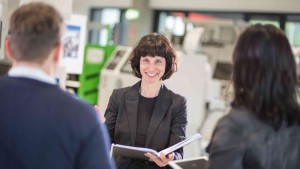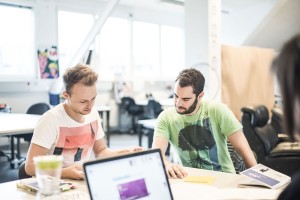Daniel Perraudin, BA
Daniel Perraudin is a Type & Graphic Designer. He discovered his passion for typography during his bachelor's degree.
Jobtitle: Type & Graphic Designer
Company: Capitale Design Studio
You started studying in 2003 - did you have a passion for typography from the beginning?
"I remember well that, relatively soon in my studies, I started drawing letters during class, at that time I had no idea how it actually worked. These sketches are really grotty. But I like to show them to the students at the beginning of my typography lectures so that they can see that we all start from nothing. At that time, however, I already noticed that I really enjoyed it and tried to develop my own formal language from it. These efforts culminated in my diploma thesis, for which I developed my own typeface. Today, Parka is the FH's house font, and that's where I've come full circle, so to speak."
What happened next for you after the diploma?
"I knew at that point that I was passionate about typography, so I started by developing my own typeface further - at that time it was only available in a regular cut, and I knew that, if I wanted to do something with it, it would have to be given many more characters and, above all, cuts. At the same time, I had to earn money first, so I looked for a permanent job at KMS in Munich in the corporate design/typography department. But type development was permanently in my head, and after 2.5 years I applied for the Type and Media Master’s in The Hague."
Was it easy to get accepted there?
"Well, the application was quite a head over heels action. I realised when I was researching this Master’s that I only had two weeks left to apply, and then putting all the documents, certificates, portfolio etc. together alongside the actual work was extremely stressful for a short while. But I thought, I'll just apply, it'll be fine. In retrospect, that was totally presumptuous on my part because I didn't know at the time that they were only offering 12 study places out of over 200 applicants. What a stroke of luck it was to be accepted there only became clear to me in retrospect. The Master's was extreme in every respect, I don't think I've ever worked so much in my life as I did there. We were all in this cocoon, we pushed each other, everyone felt driven by the collective - there was really only the academy during that time. I spent 24h a day just talking about writing, it was like a year-long bootcamp with a super high nerd potential!"
What happened next for you after that?
"I first went to Leipzig for two years, worked independently on my own projects and with an office friend in the field of guidance & orientation systems. In 2015, I moved to Berlin and worked on several projects with my former student colleague Cora. This contact then deepened more and more, and in 2016 we said: let's give the baby a name, and then we founded our joint office."
What is your core content focus in your company?
"Our focus is on typographically savvy design, so type always plays an important role. At its core, there are three main areas of content: editorial design, branding (we just redesigned the Karlsruhe University of Applied Sciences) and guidance and orientation systems. Type design is my own hobby besides my office work. I have published two typefaces so far, two more are to follow now - I think this passion will not let me go. And every now and then, I still think about going into type design completely, but we'll see..."
What do you find appealing about designing a guidance system?
"It depends on the possibilities: I appreciate it when a guidance system is very straight and very functional. That's basically what we learned in the degree programme from the beginning, namely to break down a lot of information to its essence and to offer the right morsels at the right time. It is also fascinating that so many disciplines come together in a signage system: typography, architecture, space, psychology of perception... For example, on the one hand you have to be able to read plans, but on the other hand, you have to be able to develop a language for different places that fits the architecture and the history of the place.





